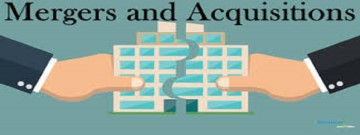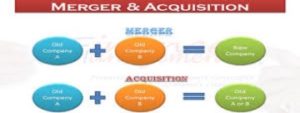Introduction
Merger & Acquisitions have throughout time been completed for a number of reasons. History demonstrates to us the varying levels of success these approaches have yielded over time. This article offers both merger examples and acquisition examples as a way to demonstrate the differences between the two, the reasons they may be preferred, and frameworks for identifying those strategic choices. The article concludes with a discussion of a selection of some of the most significant mergers in history.

Merger and Acquisition Example Definition
A merger is a voluntary fusion or agreement that combines two existing companies on broadly equal terms into one new legal entity. This combination of the two companies involves a transfer of ownership, often through a stock swap between the two companies. It is common that both companies surrender their stock and issue new stock in the new legal entity.
An acquisition, sometimes called a buyout, refers to taking control of the target company by buying all the target stock. Although control of the target can be obtained with a majority of the voting stock (generally greater than 50%), it is common that an acquirer will seek full control (100%) of the target. In the case of the target being a public company, this transaction will take the target private and it will become integrated or a fully owned subsidiary of the parent. Subsequently, the outstanding stock is cancelled. Although we use the terms Merger and Acquisition interchangedly in this article, a full explanation of the differences can be found in The Differences Between Mergers and Acquisitions – Examples & Explanations.
Reasons for Corporate Mergers
There are a number of reasons why companies may choose to merge. The table below gives 10 examples of advantages to be gained by merging firms with a general indication as to how it fits in with the overall corporate strategy.
| Advantage | Strategic Direction |
Expanding technical knowledge Deepening cash reserves Filling gaps in product lines Gaining access to new markets Freezing out competitors Increasing distribution channels Increasing revenues and profits Reducing operation costs Strengthening infrastructure Uniting common products | Expansive Defensive Expansive Expansive Defensive Expansive Expansive Defensive Expansive Expansive |
Although these mergers can be viewed as either defensive or expansive, they all have common traits. These are the survival of the firm and the preservation / enhancement of shareholder value. If the target has been selected correctly and the merger implemented successfully, mergers may result in a stronger company with increased assets, skills and market access.
However, should the target partner not be researched sufficiently, the merger may not be as successful as anticipated. Mergers often fail because of a clash of corporate cultures between the two companies, a reluctance to restructure redundant management and operations, incompatibilities of the technologies used by the companies or disruptions in the workforce.

Types of Mergers & Acquisitions
The traditional framework for evaluating types of mergers and acquisitions consists of five variants shown in the image below. Although this has been expanded and improved upon over the years, we include it for the sake of simplicity before moving on to more elaborate frameworks.

Horizontal Merger
A merger between companies that are in direct competition with each other in terms of product lines and markets. Horizontal mergers are done to increase market power (market share), further utilize economies of scale, and exploit merger synergies. For a more in-depth look at vertical mergers see our article Horizontal Mergers With Examples – A Complete Guide.
Vertical Merger
A merger between companies that are along the same supply chain (e.g., a retail company in the auto parts industry merges with a company that supplies raw materials for auto parts.) The rationale behind a vertical merger includes higher quality control, better flow of information along the supply chain, and merger synergies. For a more in-depth look at vertical mergers see our article Vertical Mergers With Examples – A Complete Guide.
Market-extension Merger
A merger between companies in different markets that sell similar products or services. For example, RBC Centura’s merger with Eagle Bancshares Inc. in 2002 was a market-extension merger that helped RBC with its growing operations in the North American market. Eagle Bancshare owned Tucker Federal Bank, one of the biggest banks in Atlanta, with over 250 workers and $1.1 billion in assets.
Product-extension Merger
A merger between companies in the same markets that sell different but related products or services. For example, the merger between Mobilink Telecom Inc. and Broadcom is a product-extension merger. The two companies both operate in the electronics industry and the resulting merger allowed the companies to combine technologies. The merger enabled the combination of Mobilink’s 2G and 2.5G technologies with Broadcom’s 802.11, Bluetooth, and DSP products. Therefore, the two companies are able to sell products that complement each other.
Conglomerate Merger
A merger between companies in unrelated business activities (e.g., a clothing company buys a software company. Companies with no overlapping factors will only merge if it makes sense from a shareholder wealth perspective, that is, if the companies can create synergy. A conglomerate merger was formed when The Walt Disney Company merged with the American Broadcasting Company (ABC) in 1995. Although conglomerates have been popular in the past, they are now viewed as restricting innovation and thus failing to create shareholder value.

Real Life Examples Of Acquisitions
Mergers & Acquisitions can occur within all industries and between companies of all sizes. Some prominent examples of acquisitions include:
Disney (DIS) and Pixar / Marvel Acquisition
In 2006, Walt Disney Co. acquired Pixar for $7.4 billion. Since then, movies such as Finding Dory, Toy Story 3, and WALL-E, have generated billions in revenue. Three years after the Pixar acquisition, Disney’s CEO Bob Igner, set out to acquire Marvel Entertainment for $4 billion.
Considering 11 Marvel movies have brought in more than $3.5 billion since the acquisition, this is a good example of a successful acquisition across all fronts.
Google (GOOG, GOOGL) and Android Acquisition
In 2005, Google acquired Android for an estimated $50 million. At the time of the deal, Android was an unknown mobile startup company. The move made it possible for Google to compete in a market controlled by Blackberry and Apple’s iPhone. This deal is a successful acquisition example, 54.5 percent, of U.S. smartphone subscribers use a Google Android device as of May 2018.
Vodafone (VOD) and Mannesmann Merger
The merger between Vodafone and Mannesmann occurred in 2000, and was worth $180 billion. This is the largest global mergers and acquisitions transaction in history. Vodafone, a mobile operator based in the United Kingdom, acquired Mannesmann, a German-owned industrial conglomerate company. This deal made Vodafone the largest mobile operator, and aimed to set the stage for future telecom deals.
In the 1990’s mobile phones were become mainstream, and fueled excitement among telecom providers, including Vodafone. Vodafone previously spent $60 billion buying AirTouch, a U.S. cellular company in 1999, but it was the launch audacious bid to buy Mannesmann in 2000 that really set the sector alight. This merger subsequently failed spectacularly. After Mannesmann rejected Vodafone’s first offer, Vodafone raised its offer to about $180 billion to secure the deal. Unfortunately, this overpayment didn’t work out the way Vodafone hoped. As a result, it had to write off tens of billions of dollars in the following years destroying vast amounts of shareholder wealth.
Anheuser-Busch InBev (ABI)
Anheuser-Busch InBev is an example of how mergers work and unite companies together. The company is the result of multiple mergers, consolidation, and market extensions in the beer market. The newly named company, Anheuser-Busch InBev, is the result of the mergers of three large international beverage companies—Interbrew (Belgium), Ambev (Brazil), and Anheuser-Busch (United States).
First Interbrew, a Belgium company, merged with Ambev, a Brazilian company. Then Anheuser-Busch merged with them, uniting the first, third, and fifth largest brewers in the world into one. This example represents both horizontal merger and market extension as it was industry consolidation but also extended the international reach of all the combined company’s brands.
More Real Life Examples Of Acquisitions
TCS (NSE: TCS) and CMC
In this merger, TCS absorbed CMC into itself, thereby consolidating their IT businesses into one with greater financial flexibility and strength, further reach, a more rationalized structure, a more focused operational effort, standardized and simplified business processes, and greater productivity. This is an example of a purely horizontal merger.
Sun Pharmaceuticals (NSE: SUNPHARMA) and Ranbaxy
In this deal, Sun Pharmaceutical absorbed Ranbaxy in order to fill Sun’s gaps in its US market, gain greater access to emerging markets, and increase its presence domestically. This also made Sun the largest generic company in dermatology products.
Amazon (AMZN) / Whole Foods
In 2017, Amazon bought Whole Foods which is a high-end organic grocery chain for $ 13.7 Billion. The acquisition provided Amazon with hundreds of physical stores and strong entry into the grocery business.
Disney (DIS) / Century Fox
In 2017 itself, Disney announced a deal to buy major assets of Century Fox assets in a historic $ 52.4 billion deal which includes the Century’s movie streaming all Hulu.
Key Takeaways
- A merger is a voluntary fusion or agreement that combines two existing companies on broadly equal terms into one new legal entity
- There are a number of reasons why companies may choose to merge, such as gaining access to new markets or technology (expansive) or reducing costs (defensive)
- The traditional framework for evaluating types of mergers and acquisitions consists of five variants
- Horizontal Merger
- Vertical Merger
- Market-extension Merger
- Product-extension Merger
- Conglomerate Merger
- Mergers can occur within all industries and between companies of all sizes. The merger between Vodafone and Mannesmann was worth $180 billion and is the largest global merger in history
Finding this information useful? Here's what you can do to help...
- Share this page using the toolbar links at the left of your screen or at the bottom for mobile users on your preferred social network
- Sina Weibo
- Twitter etc.
- Follow us on twitter @MergeArbLimited.
- Become friends with us on Facebook
- Register for news alerts and merger arbitrage deal analysis postings via email using the sign up form.
- In addition to these, an RSS feed is also available at the bottom right of the page.
- Contact us using the details given on the Contact Us page.
- Donate using the paypal widget in the sidebar. It’s gladly appreciated and we need the coffee! See the Paypal section for additional incentives
- Share this page using the toolbar links at the left of your screen or at the bottom for mobile users on your preferred social network
Thanks for reading!







